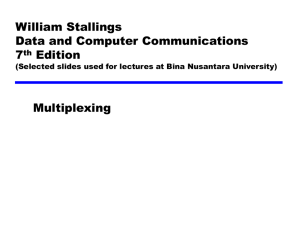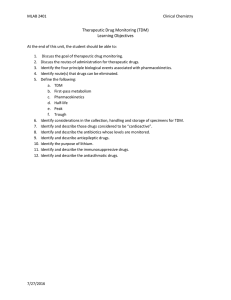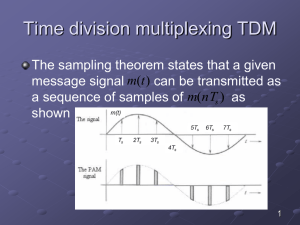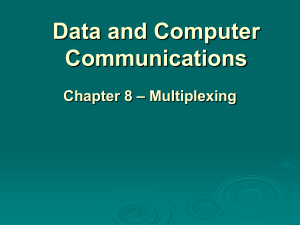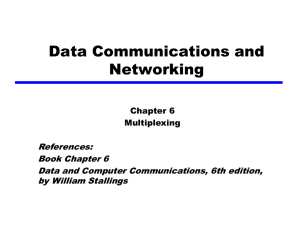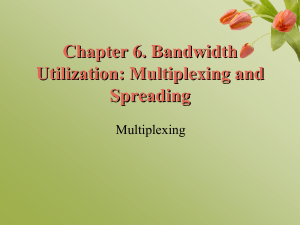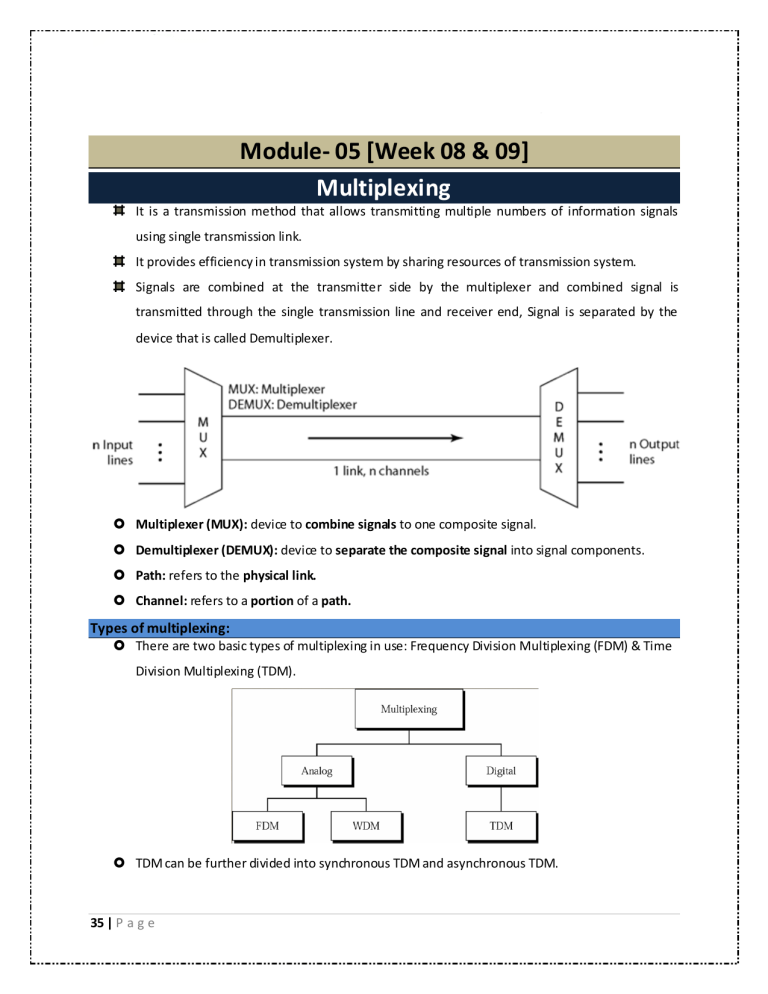
Education for Liberty Prepared by- Mohaiminul Islam, Lecturer & Coordinator (Dept. of EEE) Module- 05 [Week 08 & 09] Multiplexing It is a transmission method that allows transmitting multiple numbers of information signals using single transmission link. It provides efficiency in transmission system by sharing resources of transmission system. Signals are combined at the transmitter side by the multiplexer and combined signal is transmitted through the single transmission line and receiver end, Signal is separated by the device that is called Demultiplexer. Multiplexer (MUX): device to combine signals to one composite signal. Demultiplexer (DEMUX): device to separate the composite signal into signal components. Path: refers to the physical link. Channel: refers to a portion of a path. Types of multiplexing: There are two basic types of multiplexing in use: Frequency Division Multiplexing (FDM) & Time Division Multiplexing (TDM). TDM can be further divided into synchronous TDM and asynchronous TDM. 35 | P a g e Education for Liberty Prepared by- Mohaiminul Islam, Lecturer & Coordinator (Dept. of EEE) FDM [Frequency Division Multiplexing] Frequency Division Multiplexing (FDM) is the technique to combine signals from different bands. Each signal modulates a separate carrier frequency. Carrier frequencies are separated by sufficient bandwidth to accommodate the modulated signal. Channels can be separated by strips of unused ba1\ndwidth “guardbands” to prevent signals from overlapping. FDM is an analog technique that can be applied when the bandwidth of a link (in hertz)is greater than the combined bandwidths of the signals to be transmitted. FDM Process: 36 | P a g e Education for Liberty Prepared by- Mohaiminul Islam, Lecturer & Coordinator (Dept. of EEE) Example 1: Assume that a voice channel occupies a bandwidth of 4 kHz. We need to combine three voice channels into a link with a bandwidth of 12 kHz, from 20 to 32 kHz. Show the configuration, using the frequency domain. Assume there are no guard bands. Solution: We shift (modulate) each of the three voice channels to a different bandwidth, as shown in Figure 8. We use the 20- to 24-kHz bandwidth for the first channel, the 24- to 28-kHz bandwidth for the second channel, and the 28- to 32-kHz bandwidth for the third one. Then we combine them as shown in Figure. Example 2: Five channels, each with a 100-kHz bandwidth, are to be multiplexed together. What is the minimum bandwidth of the link if there is a need for a guard band of 10 kHz between the channels to prevent interference? Solution: For five channels, we need at least four guard bands. This means that the required bandwidth is at least (5 × 100 )+ (4 × 10) = 540 kHz, as shown in Figure. 37 | P a g e Education for Liberty Prepared by- Mohaiminul Islam, Lecturer & Coordinator (Dept. of EEE) WDM [Wavelength Division Mulitplexing] WDM is a special case for FDM used in fiber optics. Different signals are separated by wavelength, not frequency. Sometimes called Wave Division Mulitplexing. More common use of WDM is Dense WDM (DWDM), which combines hundreds of optical sources together into one fiber. An optical prism is used for WDM multiplexing and demultiplexing. Different wavelengths are refracted (bent) by different amounts. TDM [Time Division Multiplexing] TDM is a digital multiplexing technique for combining several low-rate digital channels into one high-rate one. Time Division Multiplexing (TDM) is the process of combining signals together in the time domain. The basic principle of TDM is Sampling Theorem. The basic unit in TDM is Time Slot. The data in TDM is grouped into Frames, which consists of one cycle of time slots. We can divide TDM into two different schemes: synchronous and statistical. 38 | P a g e Education for Liberty Prepared by- Mohaiminul Islam, Lecturer & Coordinator (Dept. of EEE) Synchronous TDM: In synchronous TDM, a round of data units from each input connection is collected into a frame. If we have n connections, a frame is divided into n time slots and one slot is allocated for each unit, one for each input line. If the duration of the input unit is T, the duration of each slot is Tin = T/3 and the duration of each frame is T. Empty slots: Sometimes an input link may have no data to transmit. When that happens, one or more slots on the output link will go unused. That is wastage of bandwidth. Statistical TDM can improve the efficiency. Empty slots Data rate Management: Not all input links maybe have the same data rate. Some links maybe slower. There may be several different input link speeds. There are three strategies that can be used to overcome the data rate mismatch: multilevel, multislot and pulse stuffing. 39 | P a g e Education for Liberty Prepared by- Mohaiminul Islam, Lecturer & Coordinator (Dept. of EEE) Fig: Mutilevel Multiplexing Fig: Multislot Multiplexing Fig: Pulse Stuffing TDM in Digital telephony system: 01. E1-TDM (used in European and Asian Countries) 02. T1-TDM (used in American and Japanese Countries) For both system, Sampling period = 8 KHz = 8000 samples/sec Sampling period = 1/8 KHz = 125 µsec E1-TDM hierarchy: Frame size = 32x bits = 256 bits E1bit rate = sampling rate x 8 bit x Total channel number = 8 Kbps x 8 bit x 32 = 2.048 Mbps 40 | P a g e Education for Liberty Prepared by- Mohaiminul Islam, Lecturer & Coordinator (Dept. of EEE) T1-TDM hierarchy: T1 frame size = 24 x 8 x 1 (signal bit) = 193 bit T1 bit rate = 1/ (125 usec / 193) = 1.544 Mbps Statistical TDM: It assign tie slots dynamically to the sources If there is no data for transmitting time slot will be deleted from the frame. It is more efficient. 41 | P a g e Education for Liberty Prepared by- Mohaiminul Islam, Lecturer & Coordinator (Dept. of EEE) Possible Questions: Q.01: Explain multiplexing process. Write down the types of multiplexing. Q.02: Explain FDM process. Q.03: Explain WDM process. Q.04: Explain TDM process. Q.05: Explain synchronous TDM process. Q.06: What is an empty slot? Explain data rate management process in case of empty slots. Q.07: Differentiate in between synchronous TDM and statistical TDM. Q.08: Explain TDM in digital system. Briefly describe the hierarchy of E1-TDM and T1-TDM. Mathematical Problems: Q.01: Assume that a voice channel occupies a bandwidth of 4 kHz. We need to combine three voice channels into a link with a bandwidth of 12 kHz, from 20 to 32 kHz. Show the configuration, using the frequency domain. Assume there are no guard bands. Q.02: Five channels, each with a 100-kHz bandwidth, are to be multiplexed together. What is the minimum bandwidth of the link if there is a need for a guard band of 10 kHz between the channels to prevent interference? THE END… 42 | P a g e
